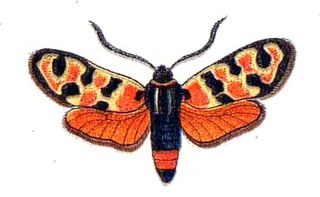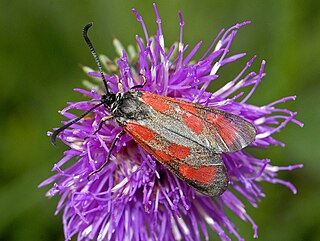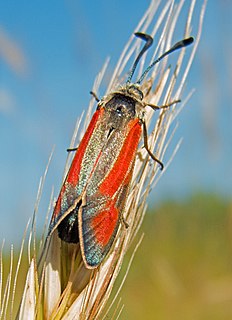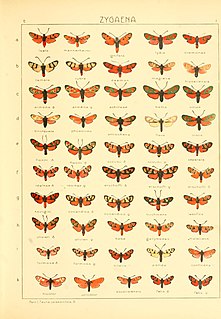
Zygaena transalpina is a moth of the family Zygaenidae.

Zygaena is a genus of moths in the family Zygaenidae. These brightly coloured, day-flying moths are native to the West Palearctic.

Zygaena carniolica, sometimes described as the crepuscular burnet or eastern burnet, is a member of the family Zygaenidae.

Zygaena ephialtes is day flying species of burnet moth found in Europe. It is typically found in xeric habitats, and populations have recently decreased. It also exhibits Müllerian mimicry with other species, like Amata phegea.

Zygaena fausta is a member of the family Zygaenidae, the day-flying burnet moths. Its bright aposematic colours of red, white and black on the wings indicate to possible predators such as birds that it is foul tasting or poisonous. In flight, the bright red abdomen is revealed, contrasting with the white legs and black head and antennae; the thorax is black and white with an eye spot on each side. There appears to be a considerable variation in pattern among specimens from different parts of Europe.

Zygaena loti, the slender Scotch burnet, is a moth of the family Zygaenidae. It is only found on the islands of Mull and Ulva.

Zygaena lonicerae, the narrow-bordered five-spot burnet, is a moth of the family Zygaenidae. The species was first described by Theodor Gottlieb von Scheven in 1777.

Zygaena fraxini is a moth of the family Zygaenidae.It is a Palearctic confined to Western Asia.

Zygaena purpuralis, the transparent burnet, is a moth of the family Zygaenidae.

Zygaena sarpedon is a moth of the Zygaenidae family. It is found in France, Italy and on the Iberian Peninsula.

Zygaena hilaris is a species of moth in the family Zygaenidae.

Zygaena brizae is a species of moth in the Zygaenidae family. It is found in France, Italy, Austria, the Czech Republic, Poland, Slovakia, Hungary, the Balkan Peninsula, Moldova, Ukraine, Russia and Georgia.

Zygaena cynarae is a species of moth in the Zygaenidae family. It is found from France east to Russia.

Zygaena punctum is a species of moth in the family Zygaenidae. It is found in Poland, the Czech Republic, Slovakia, Austria, Slovenia, Italy, the Balkan Peninsula, Moldova, Ukraine, Russia and Turkey.

Zygaena angelicae is a species of moth in the Zygaenidae family. It is found in Central Europe, from Greece to southern Germany and Thuringia. Z.angelicae has blue-black or green-black forewings, whose inner angles are strongly rounded off. On the forewings there are five or six red spots, two of which are always close together. In the five-spotted individuals, the spots on the underside of the wings are connected by a red stripe, in the six-spotted ones this is a large patch. The black margin of the red hind wings is wide. The antennal club is white at the tip less so than in Zygaena transalpina and the white may be completely absent. The wingspan is 30–33 mm.

Zygaena dorycnii is a species of moth in the family Zygaenidae. It is found in Ukraine, Russia, Turkey and Armenia.

Zygaena rhadamanthus is a species of moth in the Zygaenidae family. It is found in France, Spain, Portugal and Italy.

Zygaena magiana is a species of moth in the Zygaenidae family. It is found in Central Asia.

Zygaena felix is a species of moth in the Zygaenidae family. It is found in south Spain and the Atlas mountains.In Seitz it is described. — In felix Oberth., from Algiers and South-West Spain, the black spots are more or less confluent, the red ground-colour along the distal margin being sometimes separated as a sock-like halfmoon.The white edges are usually altogether absent, or there are only feeble vestiges of them — In ab. faustula Stgr.-Reb.[ now Z. felix ssp. constantinensis Reiss & Tremewan, 1964] on the contrary the black spots are distinctly edged with yellowish white. — Lastly, ab.mauretanica Stgr. [now Z. felix ssp. constantinensis Reiss & Tremewan, 1964] (8a) has a red belt. — The 3 forms tly exactly at the same time and the same places; I found them frequently united in copula. They are extremely common throughout June on nearly all the heights of the Atlas Mts., sometimes the one sometimes the other form being prevalent in the various flight-places.

Zygaena favonia is a species of moth in the Zygaenidae family. It is found in the Atlas mountains, .In Seitz it is described Z. favonia Frr. (4g). This form belongs to a group of North African Burnets the pattern of the forewings of which reminds one much of the preceding species [ Zygaena sarpedon, while the abdomen is red from the middle nearly to the tip, which gives the insect a characteristic aspect and renders it easy to recognize even when it flies quickly past. The whole of Mauretania, everywhere common — ab. vitrina Stgr. (4g) [ now Z. favonia ssp. valentini Bruand, 1846], which I found only at very limited localities, for instance near Constantine and at the cemetery-wall near Batna, is easily differentiated by the transparent wings. -ab. staudingeri Aust. (4f) [ now Z favonia Freyer, 1844] is similar, but has only a narrow abdominal belt, so that one might mistake the for a small loyselis, if it did not lack the red collar of the latter. — The insect described by Bruand as valentini [ now Z. favonia ssp. valentini Bruand, 1846], in which the red spots are enlarged, may possibly belong to an analogous favonia-form. — The finest form of this group is thevestis Stgr. [now Z. favonia ssp. thevestis Staudinger, 1887 (4f), in which there is a large lobate subapical patch. — All these varieties occur all over Mauretania, on hills, in dry beds of rivulets, and on waste ground. The commonest form is favonia, which is found in June on nearly all the thistles growing at the road-sides and in the fields. The females have an extraordinarily thick body, and apparently scarcely take to the wing before copulation.



















